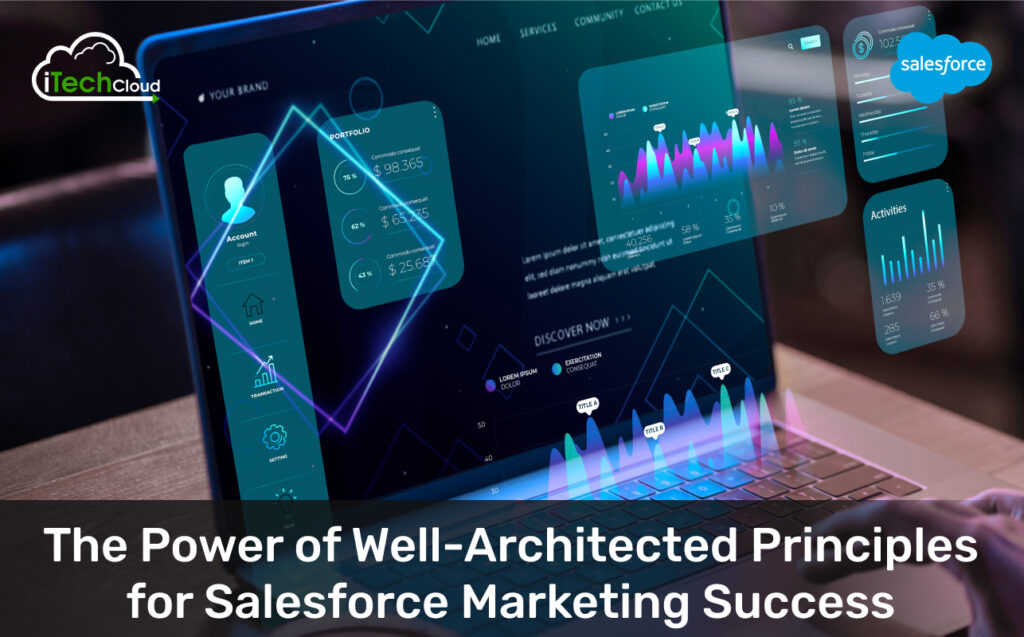The Power of Well-Architected Principles for Salesforce Marketing Success

As businesses increasingly prioritize customer engagement and digital transformation, Salesforce remains a central tool for executing powerful, data-driven marketing strategies. But simply using Salesforce Marketing Cloud or Account Engagement (formerly Pardot) is no longer enough. To fully unlock its potential, organizations must build on a solid foundation guided by Well-Architected Principles.
These principles help businesses design and operate Salesforce solutions that are scalable, secure, high-performing, and optimized for long-term success. In the context of marketing, they ensure that every campaign, journey, and customer interaction is strategically planned, technologically sound, and aligned with measurable business goals.
This blog explores how Salesforce Well-Architected Framework can reshape your marketing strategy and drive sustained customer success.
Table of Contents
Understanding the Salesforce Well-Architected Framework
The Salesforce Well-Architected Framework provides a structured methodology for assessing and improving how Salesforce solutions are implemented. It is divided into four distinct layers:
- Foundational Layer: Defines governance, compliance, and enterprise architecture strategy.
- Capability Layer: Focuses on business functionalities and how they’re delivered using Salesforce products.
- Platform Services Layer: Covers capabilities like integration, AI, automation, and analytics.
- Trust Layer: Ensures the security, reliability, and performance of the solution.
By applying this framework, marketers can design digital experiences that are both customer-centric and operationally efficient.
Why Well-Architected Principles Matter for Marketers
Modern marketers face the challenge of delivering personalized, omnichannel experiences while managing increasing data complexity, privacy regulations, and performance expectations. The Well-Architected Framework acts as a strategic compass, offering benefits like:
- Improved data quality and usability
- Faster time to market for campaigns
- Greater personalization and segmentation
- Enhanced compliance with data regulations
- Reliable campaign performance during peak loads
In short, it helps marketers build smarter and more scalable systems that keep pace with business growth and customer expectations.
1. Aligning Marketing Strategy with Technical Architecture
At the core of the Well-Architected Framework is the principle of alignment ensuring that the marketing strategy is tightly integrated with the technical design of your Salesforce environment.
How to Apply:
- Map business objectives to system capabilities. For instance, if your goal is to reduce lead conversion time, configure lead scoring models and intelligent nurture journeys.
- Define key marketing KPIs such as click-through rates, cost per lead, or campaign ROI, and ensure the data structure supports their accurate tracking.
- Align campaign structures, journeys, and segments with customer personas and lifecycle stages.
This alignment guarantees that your technical investments directly support marketing and business outcomes.
2. Building Trust with Data Security and Compliance
With stricter data privacy regulations (like GDPR, CCPA, and HIPAA), trust must be a foundational element of your marketing architecture. The framework promotes a “security by design” mindset, which means building secure systems from the start, not as an afterthought.
Best Practices:
- Use permission sets and roles to ensure only authorized users can access sensitive customer data.
- Encrypt data at rest and in transit using tools like Salesforce Shield or third-party solutions.
- Enable preference centers in Marketing Cloud or Pardot to manage opt-ins and consent.
- Maintain audit logs and data retention policies to support compliance reviews and customer requests.
A secure, compliant system not only builds customer trust but also protects your brand from legal and reputational risks.
3. Making Data Actionable Across Marketing Systems
Great marketing relies on accurate, unified, and actionable data. Well-Architected Marketing means having clean and connected data sources that can be leveraged for segmentation, personalization, and analytics.
Implementation Tips:
- Use Salesforce Data Cloud (CDP) to unify data from sales, service, website, and mobile interactions into a single customer profile.
- Regularly audit and clean your CRM and Marketing Cloud data to remove duplicates and outdated records.
- Leverage data extensions and contact builder in Marketing Cloud to map data relationships correctly.
- Integrate Einstein and AI tools to generate predictive insights based on customer behavior.
When marketers can trust their data, they can create campaigns that speak to the right people at the right time.
4. Intelligent Automation for Scalable Campaigns
Automation is a powerful enabler, but without proper architecture, it can become chaotic and difficult to scale. The Well-Architected approach encourages automation with purpose driven by strategy, not just convenience.
Examples in Action:
- Use Marketing Cloud Journey Builder to design cross-channel journeys that adjust based on real-time interactions.
- Build reusable automations with Automation Studio for daily tasks like data imports or segmentation updates.
- Implement Einstein Engagement Scoring to prioritize the most likely responders.
- Design custom triggers using Platform Events or APIs to respond instantly to customer actions.
Done right, automation reduces manual work while enhancing personalization and speed.
5. Connecting Systems for Unified Customer Experiences
A major cause of poor marketing performance is data silos and disconnected tools. The Well-Architected Framework emphasizes seamless integration between Salesforce and your other platforms.
How to Improve Integration:
- Connect Marketing Cloud with Sales Cloud using Marketing Cloud Connect to sync leads, campaigns, and engagement data.
- Use MuleSoft or other APIs to integrate with ecommerce, content management, or external data platforms.
- Create bidirectional data flows so sales and service teams can see real-time campaign engagement within CRM.
- Trigger marketing actions from service cases or order events using event-driven architectures.
Connected systems empower you to deliver consistent, relevant messages across the entire customer lifecycle.
6. Ensuring System Resilience and Performance
Marketing campaigns can place heavy loads on your Salesforce systems, especially during product launches or seasonal promotions. A resilient architecture ensures stable, consistent performance, even under pressure.
Actionable Tactics:
- Monitor API limits and batch processing times to avoid throttling.
- Design fallback workflows in case an automation or journey fails mid-process.
- Use monitoring tools to keep tabs on campaign performance, bounces, and deliverability.
- Conduct load testing before launching major campaigns.
Resilient systems reduce the risk of downtime or performance degradation, ensuring smooth customer experiences.
7. Managing Change with Governance and Best Practices
Without clear governance, marketing teams may create conflicting journeys, inconsistent naming, or untracked changes. Well-Architected principles encourage structured change management and documentation.
Governance Tips:
- Create a Center of Excellence (CoE) for marketing operations to set and maintain standards.
- Establish a release process using DevOps tools (like Gearset or Copado) for version control, staging, and deployment.
- Maintain playbooks and campaign templates to ensure consistency and reusability.
- Provide training and onboarding documentation to prevent knowledge gaps.
Governance ensures that as your team grows, so does your efficiency and quality.
8. Designing for Omnichannel and Personalization
Customer experiences must be unified and personalized across every channel. Whether a user interacts through email, SMS, web, or social, the message should feel consistent and contextual.
Personalization Framework:
- Use dynamic content and AMPscript to customize messaging based on real-time customer data.
- Orchestrate journeys across email, mobile push, social ads, and Experience Cloud pages.
- Implement Interaction Studio for real-time personalization and decisioning.
- Design experiences optimized for mobile responsiveness and accessibility.
By putting the customer at the center of every experience, marketers can build trust and loyalty.
Case Study: Marketing Success Through Architecture
Company: A mid-sized B2C retail brand using Salesforce Sales Cloud and Marketing Cloud.
Challenges:
- Disconnected data between ecommerce and marketing tools.
- Inconsistent segmentation and email engagement.
- Manual campaign processes leading to delays.
Solution:
- Implemented Salesforce CDP to unify customer profiles across systems.
- Built automated product recommendation journeys with Journey Builder and Interaction Studio.
- Connected ecommerce system with Marketing Cloud using APIs for real-time abandoned cart triggers.
- Created a Marketing CoE to define naming conventions, testing practices, and change controls.
Results:
- 60% increase in email click-through rates.
- 40% improvement in cart recovery conversions.
- 3x faster campaign deployment timelines.
This shows how architecture-driven marketing transforms both efficiency and customer impact.
How to Get Started with a Well-Architected Marketing Strategy
To apply these principles in your own organization:
- Conduct a marketing architecture assessment – Identify gaps in data quality, automation, integration, and governance.
- Define clear business goals and KPIs – Tie every technical decision back to measurable outcomes.
- Engage architects, developers, and marketing ops – Cross-functional collaboration is essential.
- Document standards and best practices – Start with naming conventions, folder structures, and campaign tagging.
- Measure, test, and optimize – Regularly review performance data to identify areas for improvement.
Even small steps toward architectural discipline can lead to massive long-term marketing gains.
Conclusion: Salesforce Marketing Success
Salesforce offers one of the most powerful platforms for modern marketing but only when it’s implemented with clarity, strategy, and discipline. The Well-Architected Framework gives marketing teams the blueprint they need to deliver high-impact campaigns with confidence.
By embracing its principles like strategic alignment, secure data practices, automation, integration, and governance marketers can build a future-proof foundation for customer engagement and ROI.

